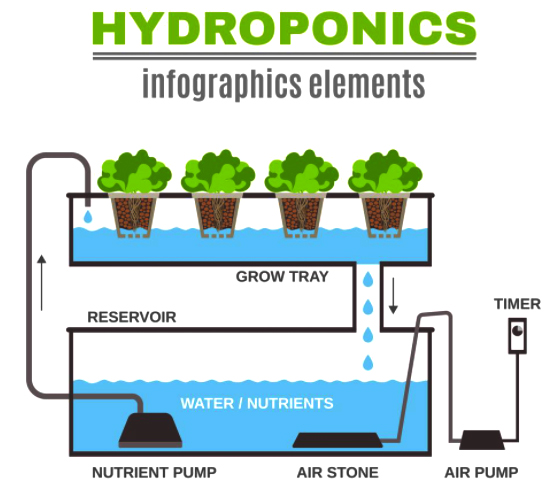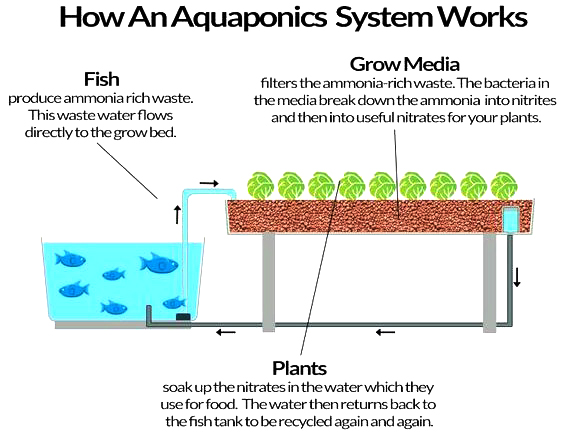Science & Technology
Soilless Farming Techniques
- 17 Aug 2021
- 9 min read
Introduction
- Soilless Cultivation generally refers to any method of growing plants without soil as a rooting medium.
- Need of Soilless Cultivation:
- Ensuring Food Security for the Increasing Population: To ensure global food security to meet the demands under uncertainty as COVID-19 pandemic and increasing population, food production must rise by 60% by 2050.
- Depletion of Resources for Traditional Farming: The natural prerequisites of agriculture, namely arable land and water, have been depleting with rapid urbanization across the globe.
- To feed the increasing population, not only does the productivity of food crops need to be increased in the existing arable land, but alternative farming techniques need to also be encouraged.
Types of Soilless Farming
Hydroponics
- Definition: Hydroponics is a method of growing plants in a water-based, nutrient-rich solution.
- Methods: In this method, the root system is supported using an inert medium such as perlite, clay pellets, peat moss or vermiculite.
- The main purpose is to provide access to oxygen which is essential for proper growth.
- Advantages:
- Land and Water Efficient: The hydroponic farming technology with closed water loop systems is a viable option for farmers with limited access to land and water.
- Suitable for Urban Areas: The significance of soilless systems increases many folds when it comes to urban and peri-urban areas where the arable land is polluted.
- Lower Resource Consumption: Lower and more efficient resource consumption allows this alternative farming technique to be adopted by a variety of stakeholders.
- Higher Yield: According to the Food and Agricultural Organisation (FAO), the vegetable yield of soilless systems is 20-25% higher than in traditional systems as the number of plants per square metre is higher.
- Drawbacks:
- Much Time and Attention Required: The water needs to be replaced at regular intervals as standing or recirculating water makes it easier for plant disease to spread if pathogens enter the water supply.
- Water and Electricity Intensive: Water and electricity are the two major factors in Hydroponic farming, in absence of adequate water supply or stable electricity, the Hydroponic system won’t thrive well.
Aeroponics
- Definition: Aeroponics is an environment-friendly way of farming in which the roots are suspended in the air and plants grow in a humid environment without soil.
- Method: It is a variation of hydroponics where both growing medium and flowing water are absent.
- The roots of the plants, in this method, are sprayed with water and nutrient solution.
- This technique enables farmers to control humidity, temperature, pH levels and water conductivity inside a greenhouse.
- Advantages:
- Decline in Water, Fertilizer and Pesticide Usage: The water usage in the system reduces by 98% and fertiliser usage by 60%.
- Pesticides are fully eliminated as the absence of soil reduces chances of diseases.
- Faster Yield: The aeroponically grown plants can be harvested three times faster and the yields are more consistent.
- As nutrients are sprayed onto the plants and roots, there's plenty of oxygen and other gases in the growing chamber for roots to absorb.
- Prevention from Climatic Impacts: Farming in a confined space gives the farmer control over pest and locust attacks and sudden heat waves.
- Decline in Water, Fertilizer and Pesticide Usage: The water usage in the system reduces by 98% and fertiliser usage by 60%.
- Drawbacks:
- High Technology-Dependency: Aeroponics is far too dependent on technology.
- If any component of the system fails or breaks, it would render the entire system completely useless.
- Deep Understanding Required: One has to be able to set up and run the Aeroponic System and also be able to create the perfect nutrient solution for the plants otherwise the plant might die.
- Expensive Technique: Aeroponics is highly costly and hence not affordable for everyone, setting up such a system can cost around Rs. 8 crore per hectare.
- Requires Constant Monitoring: The plants must receive constant attention to their pH levels and nutrient density ratio as there is no growing medium available to do this work.
- High Technology-Dependency: Aeroponics is far too dependent on technology.
Aquaponics
- Definition: Aquaponics is a system that combines hydroponics and aquaculture within a closed system.
- Methods: There are three biological components in the aquaponics process: fishes, plants, and bacteria.
- The system represents a symbiotic relationship between the plants and the fishes; the fish feces is used as fertilizer for the plants, and the plants clean the water for the fish.
- Advantages:
- Environment-Friendly: Two agricultural products (fish and vegetables) are produced from one nitrogen source (fish food).
- Such a system also prevents aquaculture waste from polluting nearby watersheds.
- Organic Fertilizer: Aquaponics farming doesn’t involve pesticides or herbicides as these chemicals may kill fish.
- In this system, the fish feces is the nutrient-rich fertilizer for the plants.
- Extremely Water Efficient: Aquaponics can result in huge water savings contrasted with a garden grown on the ground (80-90℅ water savings).
- Space Efficient: An aquaponics system can be set on any scale.
- It can be as small as an aquarium and as big as a greenhouse commercial farm.
- Environment-Friendly: Two agricultural products (fish and vegetables) are produced from one nitrogen source (fish food).
- Drawbacks:
- More Complex System: Supporting ideal environments for both plants and fishes make aquaponics a more complicated endeavor than hydroponics.
- Limited Application: It is not suitable for tuberous plants and root vegetables as they perform most of their growth within soil and aquaponics uses water as a substitute for soil.
- Multiple Points of Failure: In aquaponics, the conditions where the system can fail are more; the fish can die if they do not have the right conditions and the plants are also susceptible to pathogens.
Way Forward
- Encouraging Soilless Techniques for Food Security: Strengthening food production and distribution systems is key to fighting hunger and tackling the burden of malnutrition.
- The development of aquaponics and hydroponics embrace all dimensions of food security.
- The government shall consider these methods as viable alternatives for traditional farming and provide assistance in making these techniques affordable to a larger number of farmers.
- Providing Knowledge and Skills: While these alternative techniques can be utilized by a variety of stakeholders, from household farmers and small- to large-scale farmers, specific knowledge and skills must be developed for safe, successful and sustainable implementation.
- Facilitating Sustainable Farming: In a country like India, there is a constant pressure on agricultural land and its conversion to other uses.
- With Aeroponics and Hydroponics, the discussions around farming can move away from land constraints to focussing more on sustainable farming techniques.
- Way Ahead for Schools: Such systems are difficult but not impossible to maintain, the prerequisite is to have at least basic understandings of these systems.
- Schools might also encourage students to install Aquaponic systems at schools as their practical task for core STEM subjects like Maths, Biology, Chemistry, and Engineering.






